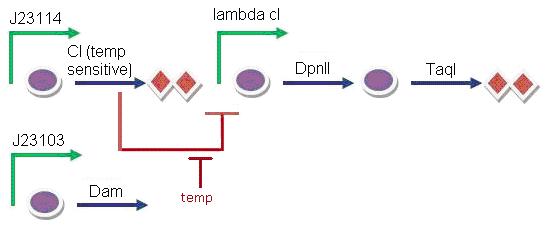Team:Imperial College London/M3/Modelling
From 2009.igem.org

- Overview
- Models
- Simulations
- Old
Background
The E. coli is killed after it has successfully produced PAH or cellulase, has encapsulated itself in colanic acid and produced trehalose to increase stability of PAH or cellulase during storage. Killing is necessary to make the pill non-toxic or pathogenic, and hence safe for human consumption. This self killing mechanism will be activated by an increase in temperatures from 28c to 42c. Therefore, this module will enable us to kill the E. coli after protein production and encapsulation has finished.

Initially, the lambda cI promoter is repressed by the protein cI that is produced constitutively under the strong promoter J23114. At 28°C, functional protein cI will bind to the lambda cI promoter to repress it. Restriction enzymes DpnII and TaqI will not be produced.
When there is an increase in temperature (from 28°C to 42°C 12), a change in conformation of the cI protein occurs. Now, protein cI will no longer be able to bind to the lambda cI promoter to repress it. In other words, there will be a de-repression of lambda cI promoter, and it will be activated, to produce restriction enzymes DpnII and TaqI. Restriction enzymes will digest the genetic material of the E. coli cells and cut the DNA, leading to cell death.
The Dam methylase, which is produced constitutively by a weak promoter J23103, will prevent cell death for redundant basal levels of production of restriction enzymes. This will ensure that unwanted cell death will not occur before we trigger this module. In this way, we can allow E. coli to produce as much PAH or cellulase as possible, with ample time for encapsulation, before we trigger cell death manually.
Dam methylase works by transferring a methyl group to the N6 position of the adenine residues in the sequence GATC[3]. As a result, restriction enzymes cannot recognise their intended cleavage site. This means that DNA will not be cleaved in the presence of Dam methylase and E. coli cells will not die. As it competes with restriction enzymes for DNA, at low restriction enzymes concentrations, Dam methylase will be able to methylate DNA and protect it. However, as the concentration of restriction enzymes increase at higher temperatures, the amount of constitutively produced Dam methylase will no longer be sufficient to protect against cell death, and cell killing occurs.
Goals
We aim to:
- Explore how temperature correlates to restriction enzyme concentration, and see how it affects the population of live cells, so as to characterise the effects of temperature on cell death.
- Develop a model of the number of dead cells as this correlates to our live and dead cells assay. (hyperlink to assay). From this, we can monitor the rate of killing and perform data analysis to obtain the necessary parameters.
- Model for cell death without Dam methylase protection.
- In a separate model, model for the effects of Dam methylase in protection against cell death. We want to know how much Dam methylase will be necessary to prevent cell death for basal production of restriction enzymes.
In summary, our model will allow us to characterise the effects of temperature on the parallel production of restriction enzymes DpnII and TaqI, that are required to kill E. coli. We can also characterise the extent Dam methylase can protect E. coli against cell death. (not yet done)
<biblio>
- 1 pmid=15652426
- 2 pmid=10235623
</biblio>
 "
"



